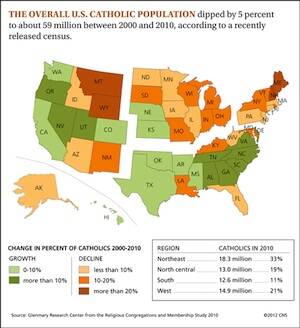The U.S. Catholic population stood at 58.9 million in 2010, according to a new census of religious congregations. That figure was below the number of 62 million Catholics reported in 2000, but the difference is due to a change in the way data was collected during this go-round, said Cliff Grammich, a researcher working for the Glenmary Research Center. Glenmary compiled statistics from 20,589 parishes, missions and other places with regularly scheduled weekend Masses.
The “2010 U.S. Religion Census: Religious Congregations and Membership” study, released on May 1, showed that the number of Catholics is three times that of the country’s second largest religious body, the Southern Baptist Convention, which has just under 20 million members. Catholic churches, missions or communities are located in 2,960 of the nation’s 3,143 counties, more than any religious body except the United Methodist Church, which claims a presence in 2,991 counties and 9.9 million members.
The new study indicates a Catholic population that is significantly lower than two other often-cited sources. The Official Catholic Directory for 2010 reported 68.5 million Catholics, and the 2010 General Social Survey of the National Opinion Research Center estimated there were 77.9 million American Catholics, based on percentages applied to the entire U.S. population.
Grammich explained that the survey’s findings are based on the definition of a Catholic in canon law as someone who is linked with the Catholic community through baptism and burial. He analyzed statistics provided by individual parishes on the number of registered households, registered individuals, infant baptisms, burials and Mass attendance to arrive at the final count. In earlier studies, less specific data was sought from individual dioceses rather than from parishes, he said.
According to Grammich, “the counts are the best that could be supported by religious data, sacramental statistics and survey data.”
Sponsored by the Association of Statisticians of American Religious Bodies, the study is conducted every 10 years and coincides with the once-a-decade U.S. census. Data was also collected from Protestant, Jewish, Muslim, Hindu, Buddhist and other religious congregations.
Catholic parishes in the Northeast and North Central states reported the greatest losses in population. Grammich attributed the decline to the number of deaths outpacing infant baptisms. By region, the Northeast maintained the highest number of Catholics, at 18.3 million. Elsewhere, 13 million Catholics lived in the North Central region, 12.6 million in the South and 14.9 million in the West.
According to the report, Catholic populations in urban areas of the Northeast and Midwest declined, while they grew in the South and West; the number of Catholic churches by region remained more stable. Nearly two-thirds (65 percent) of Catholics lived in metropolitan areas of at least 1 million residents, compared with 69 percent in 2000.
The number of Catholics grew in 19 states and increased by 10 percent or more in 10 states: Alabama, Delaware, Georgia, Nevada, North Carolina, Oregon, South Carolina, Tennessee, Utah and Virginia. The number of Catholics declined by at least 10 percent in 17 states—among them, Louisiana, Michigan, Maryland and New York, The density of the Catholic population ranged from 3.5 percent in Tennessee to 44.9 percent in Massachusetts.








